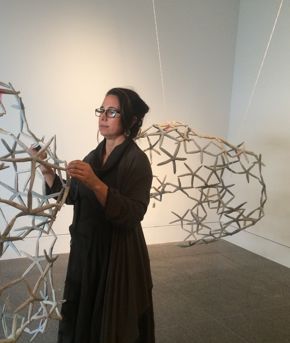Her Starfish Will Lure You In November 26, 2014

María Fernanda Cardoso works on assembling Woven Water: Submarine Landscape.
María Fernanda Cardoso, Woven Water: Submarine Landscape, 1994, dried starfish with metal wire, the Museum of Fine Arts, Houston, Museum purchase funded by the Caribbean Art Fund. © María Fernanda Cardoso
María Fernanda Cardoso unpacks starfish for Woven Water: Submarine Landscape.
Portions of Woven Water: Submarine Landscape await the next step during the assembly process.
María Fernanda Cardoso, Woven Water: Submarine Landscape, 1994, dried starfish with metal wire, the Museum of Fine Arts, Houston, Museum purchase funded by the Caribbean Art Fund. © María Fernanda Cardoso
María Fernanda Cardoso works on assembling Woven Water: Submarine Landscape.
María Fernanda Cardoso, Woven Water: Submarine Landscape, 1994, dried starfish with metal wire, the Museum of Fine Arts, Houston, Museum purchase funded by the Caribbean Art Fund. © María Fernanda Cardoso
Artist María Fernanda Cardoso would like to remind us of something very important about starfish—they are animals, not objects. You may not see eyes when you look at them, but starfish are animals, just as humans are. “I realized that starfish have five limbs,” she says, “and we have five fingers, and I thought, oh my!”
When we use our eyes to look at her installation Woven Water: Submarine Landscape, we may not even notice the starfish at first. But come closer, and you’ll see that each of the 26 clusters is made of multiple starfish, woven together with metal fasteners.
Cardoso visited Houston earlier this month to work with the Museum’s conservation department on assembling Woven Water in preparation for an exhibition of Latin American art scheduled to open in the fall of 2015.
Woven Water is an immersive environment that visitors walk through, around, and under. With this interactive installation, Cardoso wants to re-create the experience of being underwater in the ocean. Her constructions hang from the ceiling—they sway and spin, and the ones overhead evoke the rippling water at the ocean’s surface.
The starfish themselves determine the shape of each cluster. As Cardoso fastens the starfish together, the resulting form comes about responsively, depending on how each starfish fits into the next.
The Colombia native now lives in Australia, and she first became fascinated by what she calls the "seductive" qualities of starfish when she was in San Francisco. She orders the starfish from a souvenir-supply company, and even though the brilliant colors of the starfish fade over time, she prefers to preserve them in their natural state, rather than adding any paint or pigment.
Best known for her Flea Circus, Cardoso represented Colombia with Woven Water: Submarine Landscape at the Venice Biennale in 2003. She’s long been looking for the perfect space for her room-sized landscape, and now that it has entered the MFAH collection, her dream is poised to become reality. The assembled sculptures are being stored in crates until it’s time to install Woven Water in the Museum galleries next year.





